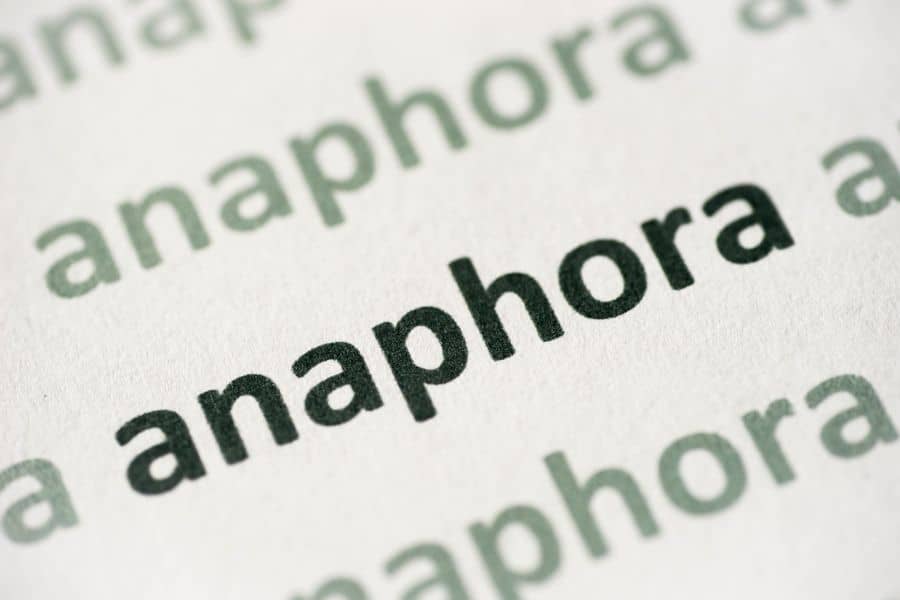As a writer, I’m always exploring new literary devices to make my writing more impactful.
And anaphora can definitely do that!
In this post, you’ll be able to identify anaphora sprinkled throughout the lyrics of your favorite songs, lines of poetry, and famous political speeches.
So, if you’re looking to distinguish anaphora from other similar literary devices and types of figurative language, you’re in the right place.
And if you’re looking for reasons anaphora is used in writing (or where it’s applicable in your own creative writing), look no further.
Read on, my friend!

What is Anaphora?
Anaphora, pronounced [a – naf – o – ra], is a literary device that lends emphasis to words through deliberate repetition of similar words or phrases at the beginning of successive clauses or sentences.
In persuasive verbal or written works, anaphora also acts as a rhetorical device that engages the emotions (pathos) of the audience.
Repetition for emphasis is a common writing technique. To distinguish anaphora from other literary devices, let’s compare it to its variants.
Epistrophe: The Opposite of Anaphora
The antonym of anaphora is epistrophe, which is the rhetorical repetition of a word or phrase at the end of successive sentences or clauses.
Epistrophe functions very similarly to anaphora in poetry or speeches, creating a rhythm that draws more attention and emphasizes an idea or statement.
Abraham Lincoln’s Gettysburg Address ended in epistrophe:
“- and that government of the people, by the people, for the people, shall not perish from the earth.”
Symploce: Combination of Anaphora and Epistrophe
A blend of anaphora and epistrophe, symploce is the repetitive words or a repeated phrase at the beginning and end of successive sentences. President Bill Clinton’s “A Time of Healing” speech after the Oklahoma City bombing included symploce:
“When there is talk of hatred, let us stand up and talk against it. When there is talk of violence, let us stand up and talk against it.”
Repetition and rhythm are at work here again, with minor tweaks to phrases to emphasize the contrast between right and wrong.
15 Anaphora Examples From Literature, Poetry, Speeches, Songs, & Movies

Now that we’re familiar with what anaphora is, some examples of anaphora in literature, poetry, rhetorical speeches, song lyrics, and movie scripts will help demonstrate its contextual effect.
Let’s dive in!
Anaphora Examples in Literature
One of the most memorable openings of classic literature kicks off our list of examples.
The first sentence of Charles Dickens’ novel, “A Tale of Two Cities”, draws in the reader with a rhythm of anaphoric phrases (including symploce):
“It was the best of times, it was the worst of times, it was the age of wisdom, it was the age of foolishness, it was the epoch of belief, it was the epoch of incredulity, it was the season of Light, it was the season of Darkness, it was the spring of hope, it was the winter of despair, we had everything before us, we had nothing before us, we were all going direct to Heaven, we were all going direct the other way”
J.D. Salinger used anaphora (and the Rule of Three) in “The Catcher in the Rye“ to emphasize Holden’s emotions regarding his brother’s gravesite:
“It rained on his lousy tombstone, and it rained on the grass on his stomach. It rained all over the place.”
Similarly, John of Gaunt’s monologue in William Shakespeare’s play, “Richard II” contains many phrases starting with “this”, referring to England:
“This blessed plot, this earth, this realm, this England,
This nurse, this teeming womb of royal kings,…
This land of such dear souls, this dear dear land”
Anaphora Examples in Poetry
Repetition is a structural element in poetry that helps to convey the tone or meaning behind the words to the reader.
Anaphora is one of many rhetorical tools that achieves this effect.
See how Maya Angelou intensified her will to overcome in her poem, Still I Rise by itemizing repeated forms of mistreatment using the phrase “you may”:
“You may shoot me with your words,
You may cut me with your eyes,
You may kill me with your hatefulness,
But still, like air, I’ll rise”
In the closing of her inaugural poem, The Hill We Climb, Amanda Gorman punctuated her hope for unity and healing by repeating the phrase “we will”.
Further, repetition of the distinct phrase “we will rise” (alluding to Maya Angelou’s poem) figuratively unifies citizens across various regions of the country.
“Every breath from my bronze-pounded chest,
We will raise this wounded world into a wondrous one.
We will rise from the gold-limbed hills of the west.
We will rise from the windswept northeast,
where our forefathers first realized revolution.
We will rise from the lake-rimmed cities of the midwestern states.
We will rise from the sunbaked south.
We will rebuild, reconcile and recover.”
Conversely, anaphora can emphasize opposing ideas.
In this famous example, Robert Frost began his poem, Fire and Ice with anaphora and alliteration to recognize stark differences of opinion regarding the world’s end.
“Some say the world will end in fire,
Some say in ice.”
Anaphora Examples in Speeches
Rhythm is often used to help audiences link concepts and emphasize the speaker’s point of view. Anaphora engages and lifts audiences with its rhythmic quality, and is especially effective (and common) in a political speech.
In his June 4, 1940 “We Shall Fight on the Beaches” address to the House of Commons, Winston Churchill asserted his conviction to resist the anticipated Nazi invasion:
“…we shall not flag or fail. We shall go on to the end, we shall fight in France, we shall fight on the seas and oceans, we shall fight with growing confidence and growing strength in the air, we shall defend our Island, whatever the cost may be, we shall fight on the beaches, we shall fight on the landing grounds, we shall fight in the fields and in the streets, we shall fight in the hills; we shall never surrender”
Another famous speech is from Martin Luther King Jr’s “I Have a Dream,” delivered at the non-violent civil rights March on Washington in 1963.
Anaphora underscored the urgency for change in the text of his famous speech:
“Now is the time to make real the promises of democracy. Now is the time to rise from the dark and desolate valley of segregation to the sunlit path of racial justice. Now is the time to lift our nation from the quicksands of racial injustice to the solid rock of brotherhood. Now is the time to make justice a reality”
He continued by sharing a vision for the future with successive phrases starting with “I have a dream”, concluding with his steadfast statement of faith.
“With this faith, we will be able to hew out of the mountain of despair a stone of hope. With this faith, we will be able to transform the jangling discords of our nation into a beautiful symphony of brotherhood. With this faith, we will be able to work together”
A few years later, Robert F. Kennedy mirrored Martin Luther King’s anaphoric words when announcing the assassination of his friend:
“What we need in the United States is not division. What we need in the United States is not hatred. What we need in the United States is not violence and lawlessness; but is love and wisdom and compassion toward one another”
Anaphora Examples in Songs
Like poetry, anaphora cements the message within song lyrics and binds a repeated word with rhythm.
Notice how anaphora strengthens the certainty of Sam Cooke’s love by accentuating his ambivalence about more tangible subjects in his 1960 R&B tune, Wonderful World:
“Don’t know much about history,
Don’t know much biology.
Don’t know much about a science book,
Don’t know much about the French I took.
But I do know that I love you,
And I know that if you love me, too,
What a wonderful world this would be”
Johnny Cash wrote the music and lyrics for “I Walk the Line” with repeated “I keep” phrases that illustrate his strong devotion to his wife while on tour:
“I keep a close watch on this heart of mine
I keep my eyes wide open all the time
I keep the ends out for the tie that binds
Because you’re mine, I walk the line”
“Some Nights” by Fun is another song about being away from home, but anaphora in the lyrics suggests a cadence of change and internal doubts.
“Some nights I stay up
Cashing in my bad luck
Some nights, I call it a draw
Some nights I wish that my lips could build a castle
Some nights, I wish they’d just fall off”
Sting’s lyrics for The Police’s 1983 hit, “Every Breath You Take”, certify his sinister obsession with his ex-lover through an anaphoric (and rhyming) list of everything he’s watching about her.
“Every breath you take
Every move you make
Every bond you break
Every step you take
I’ll be watching you
Every single day
Every word you say
Every game you play
Every night you stay
I’ll be watching you”
Anaphora Examples in Movies
In the movies, anaphoric lines draw attention to characters and amplify the dramatic effect of their words.
In this famous example, In “Casablanca”, Rick Blaine, dejected overseeing his lost love Ilsa, utters this memorable quote:
“Of all the gin joints in all the towns in all the world, she walks into mine.”
Likewise, audiences are still captivated by Sean’s monologue in the 1997 “Good Will Hunting” park bench scene, where anaphora structures his script, highlighting the distinction between intelligence and education.
Listen for the successive lines:
“If I asked you about art…If I asked you about women…If I ask you about war…And if I asked you about love…”
Why Use Anaphora?
Clearly, anaphora is an impactful literary technique. But why use it?
The beauty of anaphora is that it leverages the simple mechanical component of rhythm to encourage an emphasized impact on the target audience.
Rhythm captures our attention and helps our internal metronome process information and anticipate what’s coming next.
Our senses heightened, we perceive a greater emphasis on concepts, ideas, and emotional expression.
Where to Use Anaphora for Emphasis
As a writer, enhance your skillset by using anaphora to :
- draw your audience’s attention to something
- uplift or enliven your audience
- elevate the artistic effect of a character trait
- highlight a pivotal moment
- emphasize a concept
- project your point of view or state of mind
- express a strong emotion
- list similar or contrasting concepts or ideas
Anaphora subtly and elegantly drums words into your audience’s heads. Present your words in rhythmic, anaphoric form to captivate your audience and enhance your writing repertoire.
Take Inspiration From Anaphora Examples
Literary devices like anaphora give words a helping hand in expressing emphasis or emotion that words alone can’t do.
Our anaphora examples show how to identify anaphora (and other similar literary tools) while demonstrating an effective persuasive technique that’ll amplify your creative writing projects.
Be inspired to add more emotion.
Be inspired to effectively stress your point of view.
Be inspired to connect and engage with your audience.
More drama. More rhythm. More impact.
Be inspired to add more firepower to your words with your new favorite literary term, anaphora!









